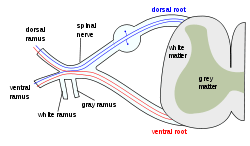Lower motor neuron lesion
| Lower motor neuron lesion | |
|---|---|
 Lower motor neuron in red | |
| Classification and external resources | |
| DiseasesDB | 22143 |
A lower motor neuron lesion is a lesion which affects nerve fibers traveling from the ventral horn or anterior grey column of the spinal cord to the relevant muscle(s) – the lower motor neuron.[1]
One major characteristic used to identify a lower motor neuron lesion is flaccid paralysis – paralysis accompanied by loss of muscle tone. This is in contrast to an upper motor neuron lesion, which often presents with spastic paralysis – paralysis accompanied by severe hypertonia.
Symptoms
- Muscle paresis or paralysis
- fibrillations
- fasciculations- caused by increased receptor concentration on muscles to compensate for lack of innervation.
- hypotonia or atonia- Tone is not velocity dependent.
- Hyporeflexia -Along with deep reflexes even cutaneous reflexes are also decreased or absent
- Strength -weakness is limited to segmental or focal pattern, Root innervated pattern
The extensor Babinski reflex is usually absent. Muscle paresis/paralysis, hypotonia/atonia, and hyporeflexia/areflexia are usually seen immediately following an insult. Muscle wasting, fasciculations and fibrillations are typically signs of end-stage muscle denervation and are seen over a longer time period. Another feature is the segmentation of symptoms - only muscles innervated by the damaged nerves will be symptomatic.
Etiology
Most common causes of lower motor neuron injuries are trauma to peripheral nerves that sever the axons - a virus that selectively attacks ventral horn cells. Disuse atrophy of the muscle occurs i.e., shrinkage of muscle fibre finally replaced by fibrous tissue (fibrous muscle) Other causes include Guillain-Barré syndrome, C. botulism, polio, and cauda equina syndrome; another common cause of Lower Motor neuron degeneration is Amyotrophic lateral sclerosis.
Differential Diagnosis
- Myasthenia gravis - synaptic transmission at motor end-plate is impaired
- Amyotrophic lateral sclerosis - causes death of motor neurons, although exact cause is unknown it has been suggested that abnormal built-up of proteins proves toxic for the neurons.
See also
References
- ↑ James D. Fix (1 October 2007). Neuroanatomy. Lippincott Williams & Wilkins. pp. 120–. ISBN 978-0-7817-7245-7. Retrieved 17 November 2010.
External links
- http://library.med.utah.edu/neurologicexam/html/motor_anatomy.html#06
Paresis and plegia NOS Flaccidity vs. spasticity Specific types